
Hoy te cuento la historia del auto que fuera el más longevo en fabricación (si en la portado no lo conoces: El VW Beetle), pero desde la perspectiva de uno de sus fabricantes y fiel amante.
Alright, let me tell ya the story of the car that held the record for the longest production run (if you ain't heard of it before, it's the VW Beetle) from the perspective of one of its makers and a die-hard fan.
Buenas,comunidad de @hivemotors, este es mi primer artículo en la comunidad, soy un gran aficionado a la historia detras de los motores. Llevo un rato publicando sobre curiosidades de automóviles en mi país, te invito a leer mis artículos anteriores, seguro te gustan y tal vez aprendas 😁.
La situación del combustible en Cuba, sigue siendo un tema tenso a tratar, pero si le vemos un poco el lado bueno, puedo decir que en lo particular, me han sucedido cosas increíbles. El artículo de hoy es muestra de esto.

La semana pasada, durante mi espera, fuí a conseguir un refresco, el calor es horrible últimamente (es como si la tierra estuviese al lado del Sol), en mi camino de vuelta, me encontré un auto del que siempre he estado enamorado... El VW Escarabajo. Me quede mirándolo, como un enamorado mira a su amada y es que estaba en muy buenas condiciones (algo que es inusual para los autos que no son los clásicos americanos). El dueño, se dio cuenta de mi interés, pense que se iba a molestar, pero sucedió todo lo contario, se puso a charlar un poco conmigo.
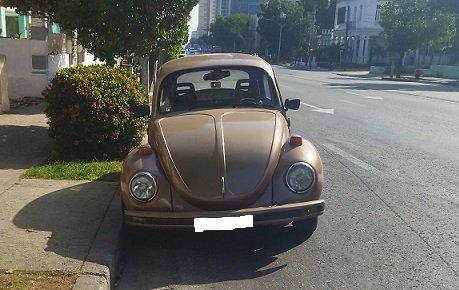
De ahora en adelante me referiré al dueño como: el viejo, el cual me autorizó a publicar este contenido pero prefiere mantenerse en el anonimato.
Resulta ser que el Viejo, durante su juventud y parte de la adultez trabajó en la fábrica de Volkswagen en Puebla, México. Esta fábrica, es la más conocida de Volkswagen, ahí se produjo el Escarabajo, hasta el final de sus días. De hecho, el modelo del Viejo (en el que ahora yo me encontraba sentado) lo había visto construir por sus amigos y el mismo, lo compró por adelantado y el mismo día que lo terminaron se lo llevó a su casa. Luego de retirarse, decidió venirse a Cuba y traerse su hermoso Vocho (así le dicen los mexicanos a este modelo), me comenta que le costó dios y ayuda, pero que por nada del mundo lo iba a dejar en México, mucha historia como para hecer eso.

El Viejo, me vió bastante interesado en la historia de este modelo y la verdad es que sí, desde chiquito el Beetle, me ha gustado por encima de otros autos que ruedan en la isla. Sin pedirlo, ya había sido invitado a sentarme en el auto y me iban a contar la historia de Volkswagen, desde una perspectiva muy personal, que más podía pedir, si yo solo iba en busca de un refresco.
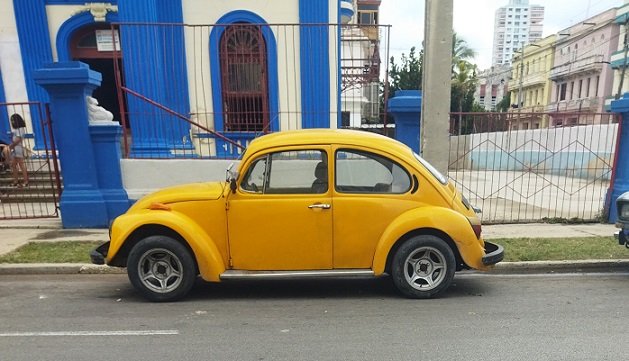
Aquel señor, se acomdó en el asiento del piloto y mirando al horizonte me dice: Comencemos por el principio jovencito... Era la década del 30 y Alemania se encontraba sumergida en una gran depresión, consecuencia de los resultados de la Primera Guerra Mundial. En 1933, Hitler anunció su propuesta de movilizacion popular, donde prometió la construcción de un sistema de carretera que conectaría al país. Pero, esa Alemania no es la conocemos hoy, era un país que se encotraba en una díficil situación y sus ciudadanos no tenían mucho dinero para el día a día (además de los miles de problemas que había dejado la guerra). El señor más odia de al historia universal, consciente de la situación, encargó la construcción de un auto accesible a la clase trabajadora. Hitler irónicamente, no poseía licencia de conducción, pero se tomó muy a pecho el diseño del modelo, con especificaciones bien claras para sus desarolladores. Luego de casi 50 bocetos y prototipos, elegieron lo que hoy conocemos como el Volkswagen Typ 1, diseñado por Ferdinad Porsche.

Por si te lo preguntas,Volkswagen en alemán significa: Volks (pueblo) y wagen (auto), el auto del pueblo y vaya que lo consiguieron.

El viejo, en ese momento se acordó de una curiosidad y me dice que los primeros modelos venían para funcionar con gasógeno (me explicó que era un sustito de la gasolina generado a partir de carbón vegetal) Según mi piloto, los primeros modelos fueron un exito rotundo, pero la producción se detendria por el inicio de la II Guerra Mundial.
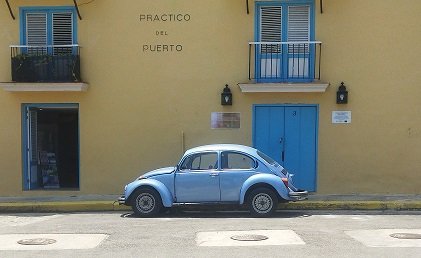
Mi nuevo amigo me cuenta que su papá era un gran fanatico y un historiador aficionado a la marca Volkswagen, ensguida intuí que su padre le había pasado su amor por el Escarabajo y cuan importante debía ser ese auto para él. Su padre, le contaba que para 1945 el gobierno alemán Para 1945, el gobierno, decidió reanudar la producción del Tipo 1 como una forma de generar ingresos para la economía aún en ruinas. Solo 5 años más tarde, comenzaría la exportación del modelo a todas partes del mundo. Se empezó a internacionalizar, siendo pieza clave para contribuir al “milagro alemán” y se convirtió en un embajador positivo para otros países del mundo, donde sería visto como un ícono de la cultura juvenil y hippie, poco más tarde.
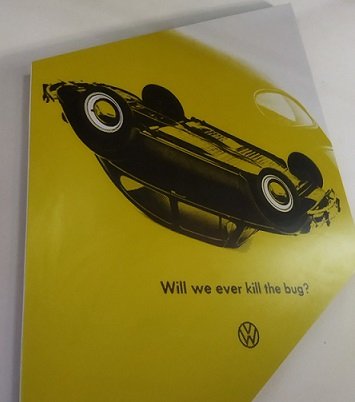 Uno de los anuncios mas famosos creados para este modelo
Uno de los anuncios mas famosos creados para este modelo
Para 1978, saldría el ultimo Beetle de la planta alemana de Emden, el viejo me dice que este fue un día muy emotivo para todos los fanáticos de la marca en todo el mundo, pero que el no lo recuerda como nada especial😅. Pero no representaba el final, El Viejo con ironía me dice que el despegue de ventas del coche del pueblo alemán tuvo lugar cuando cruzó el Atlantico, y aunque los alemanes lo nieguen el Escarabajo es más latino que alemán y es que las fabriacas de Brasil, Estados Unidos y México fueron las encargadas de continuar el legado.

En ese momento se acerca al auto, una señora que con un avoz muy dulce me dice: dile que te cuente cuando empezó a trabajar en Puebla: el viejo al escuchar esto se puso muy sentimental y dice que fue el mejor momento de su vida, que para el era más que un trabajo. Dice que aún recuerda en 1998 cuando desde su fa´brica empezaron a construir: el Volkswagen New Beetle, el cual el viejo dice que fue un auto que nunca debió nacer, porque segundas partes nunca fueron buenas. En 2003 cuando cesa la producción del Escarabajo original el viejo decide mudarse a Cuba, donde seha dedidcado a restaurar, conservar e investigar sobre este modelo.
Según unas revistas que el Viejo guarda con gran cariño en 1972 este modelo se convertiría en el más vendido (15 millones de unidades) superando al mítico Ford Modelo T.
Luego de un rico café, preparado por su esposa y degustado dentro del auto (yo me econtara en un sueño), le pido a mi nuevo amigo, que me cuente un poco, cómo llegaron a Cuba estos modelos?
Bueno, mijo, creo que como debes imaginarte no hay ningun registro oficial de cuando llegaron aquí, ni como llegaron. Aunque según lo que he podido ver en mis años como mecanico y restaurador, pudiera decirte que fue el a década del 50. Y creo que cuando empieza el perído de Fidel Castro es cuando llegan más y es que como sabes la Alemania Oriental se convirtio en buen socio de tu país. Así que creo ahi esta el origen de ellos.
Intuitivamente reviso mi celuar ya han pasado 3 horas, el tiempo vuela, seguro nos tocaba hechar combustible y además, tenía 4 llamadas de mi padre. Así que tuve que despedirme del Viejo y su dulce señora, no sin antes pedirle que me diera su número y con la promesa de que nos volvieramos a ver (hace dos días, fue a verme al hospital, me llevó, un papel donde había anotadas unas cuantas curiosidades que el recordaba del modelo, pronto se las estaré compartiendo)
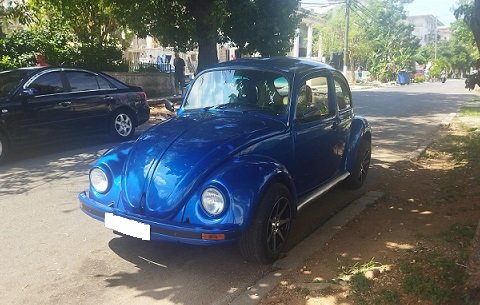
Luego que llego al auto de mi padre, me puse a pensar y quien hubiese imaginado que el utilitario alemán, ordenado por Hitler, se convertiría, en el coche de los pacifistas y en la elección de millones de familias en todo el mundo.
Si buscamos en internet, estoy seguro que este modelo esta presente en el 95 por ciento de los países del mundo.
Si llegaste hasta aquí te pregunto: Cual de todas las fotos de este artículo crees que sea el auto del Viejo? que crees de al historia de este auto? Lo comprarías? Conoces a alguien que tenga uno? Tienes uno? Quieres saber algo más?Me faltó algo y quieres aádirlo. Lo que sea, estaría encantado de seguir la conversación en los comentarios. Solo te pido que no preguntes nada técnico, porque ahí si tendría que buscar al Viejo para que lo explique.
Nos vemos en la próxima
Toda la información de este artículo fue obtenida de una conversación con uno extrabajador de las fábrica de Puebla de Volkswagen y posteriormente revisada para evitar cualquier error histórico.
Las fotos utilizadas en el artículo, son de mi propiedad. Algunas fueron hechas en la vía pública (con el previo consentimiento de los dueños de los autos) y otras en el Museo del Automovilismo en La Habana (si quieres conocer más sobre este último, pasa por mi blog, donde hay varios artículos en Español e Inglés sobre este lugar y los modelos ahí expuestos)

ENGLISH
The fuel situation in Cuba is still a touchy subject, but looking at it from an optimistic perspective, I can say that some incredible things have happened to me while waiting to fill up my tank. Today's article is proof of that.

Last week, while waiting in the never-ending fuel line, I decided to grab a soda to beat the scorching heat (it felt like I was standing on the surface of the sun!). On my way back, I stumbled upon a car that I've always been head-over-heels for... the VW Beetle. I couldn't help but stand there admiring it, like a smitten kitten. Surprisingly, it was in immaculate condition, something you don't often see with non-American classic cars. The owner noticed my interest and instead of getting annoyed, he struck up a friendly conversation with me.

From now on, I'll refer to the owner as "the old man," who gave me permission to publish this content but prefers to remain anonymous.
So, it turns out that the old man worked at the famous Volkswagen factory in Puebla, Mexico during his younger days and even as an adult. This factory was renowned for producing the iconic Beetle until its production ceased. The old man's Beetle, which I was fortunate enough to sit in, was actually built by his buddies, and he had pre-ordered it himself. The day it was completed, he drove it straight home with pride. After retiring, he made the decision to relocate to Cuba and bring his beloved "Bug" (that's what the Mexicans call this model) along with him. He shared with me that it was a real challenge getting it here, but there was no way he was leaving it behind in Mexico, as it held too much sentimental value and history.

The old man noticed how intrigued I was with the history of this model, and to be honest, I've always been a fan of the Beetle, more so than any other car that roams around the island. Before I knew it, I was invited to sit in the car, and they were about to share with me the history of Volkswagen from a very personal perspective. I couldn't believe my luck, all I wanted was a refreshing drink, and here I was getting an unexpected history lesson on my favorite car model.

The old man made himself comfortable in the driver's seat and, gazing off into the distance, said, "Let's start from the beginning, young fella..." It was the 1930s, and Germany was in the midst of a severe depression, a consequence of the aftermath of World War I. In 1933, Hitler announced his proposal for a popular mobilization, promising to construct a road system that would connect the country. However, that Germany was not the one we recognize today; it was a country in dire straits, and its citizens didn't have much money to make ends meet (not to mention the countless problems left in the wake of the war). The most despised man in world history, recognizing the dire situation, commissioned the creation of a car that would be accessible to the working class. Ironically, Hitler didn't have a driver's license, but he took the design of the model very seriously, providing clear specifications for its developers. After nearly 50 sketches and prototypes, they ultimately selected what we now know as the Volkswagen Typ 1, which was designed by the legendary Ferdinand Porsche.

In case you're wondering, Volkswagen in German means "Volks" (people) and "wagen" (car) - the people's car. And boy, did they succeed in achieving that.

In that instant, the old man recalled an interesting piece of information and shared with me that the first models were actually designed to run on gasogen (he explained that it was a gasoline substitute made from charcoal). As per my driver's account, the first models were a massive hit, but production was unfortunately halted due to the outbreak of World War II.

My new friend shared with me that his dad was a huge fan and an amateur historian of the Volkswagen brand. I immediately sensed that his father had passed down his love for the Beetle to him and how important that car must have been to him. His father used to tell him that in 1945, the German government decided to resume production of the Type 1 as a means of generating income for the still-ruined economy. Just 5 years later, the model began to be exported all over the world. It began to internationalize, becoming a key component in contributing to the "German miracle" and would later become a positive ambassador for other countries around the world, where it would be viewed as an icon of youth and hippie culture.
In 1978, the last Beetle would roll off the assembly line at the German plant in Emden. The old man told me that it was a very emotional day for Volkswagen fans worldwide. However, it didn't represent the end of the road for the Beetle. With a touch of irony, he told me that the German people may deny it, but the sales boom for the people's car occurred when it crossed the Atlantic. The truth is that the Beetle is more Latin American than German, and it's the factories in Brazil, the United States, and Mexico that were responsible for carrying on the legacy.

At that moment, a sweet-voiced lady approached the car and said to me, "Ask him to tell you about when he started working in Puebla." The old man became very sentimental upon hearing this and said that it was the best time of his life, and it was more than just a job to him. He recounted how he still remembers in 1998 when they began building the Volkswagen New Beetle from their factory, which the old man believes was a car that should have never been born since sequels are never as good as the original. When production of the original Beetle ceased in 2003, the old man decided to move to Cuba, where he has dedicated himself to restoring, preserving, and researching this model.
According to a magazine that the old man holds dear, in 1972, this model became the best-selling car (with 15 million units sold), surpassing the legendary Ford Model T.
After enjoying a delicious cup of coffee prepared by his wife, and with me still feeling like I was in a dream, I asked my new friend to tell me a bit about how these models ended up in Cuba. "Well, son, as you can imagine, there's no official record of when they arrived or how they got here. However, from what I've seen in my years as a mechanic and restorer, I'd say it was in the 1950s. And I believe that when Fidel Castro came to power, more of them arrived, as you know that East Germany became a good partner to your country. So, I think that's where they originated from."
As I checked my phone, I realized that three hours had passed in what felt like no time at all. It was probably time to refuel, and I also had missed four calls from my father. So, I had to bid farewell to the old man and his sweet lady, but not before getting his phone number and promising to see them again. (Two days ago, he came to visit me at the hospital and brought a piece of paper with some interesting facts he remembered about the model, which I'll be sharing with you soon.)

As I arrived at my father's car, I couldn't help but think that who would have ever thought that the utilitarian German car, ordered by Hitler, would eventually become the car of pacifists and the choice of millions of families worldwide. If you search the internet, I'm sure you'll find this model present in 95 percent of the world's countries.
So, I ask you: Which one do you think of all the cars in this article belongs to the old man? What do you think of the history of this car? Would you buy one? Do you know anyone who owns one? Do you have one? Do you want to know more? Did I miss something and you want to add it? I would love to continue the conversation in the comments. Just please don't ask any technical questions because then I would have to ask the old man to explain them.
See you next time.
All the information in this article was obtained from a conversation with a former worker from the Volkswagen factory in Puebla and was subsequently reviewed to avoid any historical inaccuracies.
The photos used in the article are my property. Some were taken in public spaces (with the prior consent of the owners of the cars), and others were taken at the Automobile Museum in Havana (if you want to learn more about the museum, check out my blog, where there are several articles in Spanish and English about this place and the models on display).























Amazing story. But since you are such a big fan of the classic Beetle, you will certainly be interested in this:
https://peakd.com/cars/@viggen/do-you-know-memminger
And maybe this:
https://peakd.com/cars/@viggen/does-vw-want-to-suggest
I enjoyed both articles 🤩, especially the one about luxury restorations. It's amazing what mechanics can achieve, and the Beetle definitely deserves that kind of care.
Amigo se me salieron las lágrimas, porque ese modelo de carro es un icono, lo que el viejo te trasmitió es un legado, y lo que vivistes al conocerlo es un milagro del destino, excelente post, te seguiré a partir de ahora.
Buenas amigo , no sabe lo afortunado que me he sentido de conocer a ese señor , además me ha acogido como un alumno y me ha enseñado otros modelos que pronto estaré trayendo por acá 😉
Gracias por seguirme le aseguro que no se va arrepentir , muchas historias de otros autos están por venir , la facilidad de vivir en país de autos congelados en el tiempo 😅
Gracias por leerme , comentar y seguirme 🙏🏻
Saludos tenia dos meses sin computadora, en breve revisare tus publicaciones.
Bienvenido, me alegro que esté de vuelta
Congratulations @dahpilot! You have completed the following achievement on the Hive blockchain And have been rewarded with New badge(s)
Your next target is to reach 3500 upvotes.
You can view your badges on your board and compare yourself to others in the Ranking
If you no longer want to receive notifications, reply to this comment with the word
STOPSaludos @dahpilot un abonita historia nos compartes, puedo decir con franqueza que disfrute la lectura, gracias por compartir, sin embargo, te invito a leer las normas de la comunidad que están ancladas y nos compartas más de tus experiencias como mecani6y restaurador, en el post podrás ampliar los detalles, esperamos tener más de tu contenido a futuro.
Me alegra que le haya gustado.
Le pido mis más sinceras disculpas, en uno de mis post anteriores, me recomendaron la comunidad como la más acorde para mí contenido. Leí el artículo que hace referencia a las normas y al tratarse de un auto pensé que aplicaba , nuevamente discúlpeme, le aseguro que no se va a repetir y gracias por advertirme.
Por favor siéntete libre de compartir el tipo de experiencias que se describe en el post.
Si quieres formar parte de nuestro trail de curación, ingresa a HIVEVOTE, haciendo clic en la imagen del capybara aristocratico. Capybaraexchange tu casa de cambio, rapida, confiable y segura